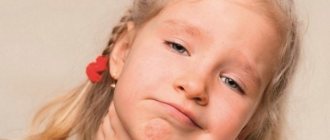In the first few years of a child’s life, the part of the brain responsible for speech development occurs. Failures that occur at this stage must be corrected. Parents often do not pay attention to the fact that the child changes syllables. However, in some cases this may indicate the presence of a deviation, so it is better to consult a specialist. If he discovers a pathology, then only a speech therapist can help get rid of it. But don’t worry too much if your baby gets confused about the syllables. In some cases, this is an age-related phenomenon.
With normal development, three-year-old children begin to reproduce verbal structures according to the laws of euphony. At the age of 1.5 to 2 years, rearrangement of syllables is allowed. For example, instead of the word “plane,” a child may say “baby.” But if such violations do not disappear by 4-5 years, then this indicates the presence of a violation of the syllabic structure of the word. Such problems do not go away on their own, so the help of a speech therapist is necessary.
Types of syllabic disorders
Violation of the syllabic structure of a word is a type of GSD (general speech underdevelopment). OHP occurs in children with minimal brain dysfunction, neurological and psychopathic syndromes and organic lesions of the speech parts of the brain, as well as due to pedagogical neglect. When the syllable structure is violated, experts identify several types of deviations:
- elision. The child shortens words and skips syllables (“bicycle” - “siped”, “TV” - “tizoy”, etc.);
- iterations. The baby increases the number of syllables by adding vowels to them (“room” - “room”, “pumpkin” - “pumpkin”, etc.);
- perseveration. The baby gets stuck on a syllable and repeats it several times (“suitcase” - “che-ma-ma-dan”, “kitty” - “ko-shech-shech-ka”, etc.);
- anticipation. The child changes the next syllable to the previous one or selects a similar one, swaps sounds (“dog” - “babaka”, “frog” - “gugushka”, “hammer” - “tamalok”, etc.);
- contamination. The kid mixes words with each other, swaps the sequence of sounds (“the doctor is treating” - “docchit”, “on the table in the hospital” - “on the table”).
Remember that the development of correct syllable structure is a necessary stage in the formation of a child’s speech, influencing subsequent writing and reading skills.
Oral exercises to strengthen the skill of dividing words into syllables
The following exercises will help you clearly demonstrate the topic:
- Experiment with a candle. Light a candle. Sit opposite. Say loudly, actively exhaling air, different words. For every syllable the flame will oscillate. Count together the number of hesitations for each word. It will also be interesting for the child to come up with words himself and count the number of syllables in them. Experiment: name short one-syllable words, and then come up with long ones that will make the flame fluctuate many times.
- Hand clapping. Invite the boy or girl to clap their hands for each syllable in the word. Let the words compete to see which one will receive more applause.
- Let's try it by touch. Place your horizontally straightened hand under your chin. Let your little scientist do the same. Pronounce monosyllabic and polysyllabic words. For each syllable, the chin and mouth will move and the mouth will open.
- Pedometer. Imagine that every step you take is one syllable. Say the words and step on each syllable. Ask your child how many steps it takes to say different words. First, do the exercises with your child. And then let him learn to use pitch to measure the number of syllables on his own.
- Young musician (builder, telegraph operator). Try to designate each syllable with some sound (beat on a drum, knock of a hammer) that your child likes. How will the words sound?
To master the material, give your child the opportunity to measure the syllables in steps, feel them with his hands and create his own unique melodies for each word.
Norms for the formation of the syllable structure of a word at different ages
- Children from 0 to 3 years old. Repeating simple syllables “ma-ma”, “ba-ba”, etc.;
- Children from 3 to 4 years old. Reproduction of words of one, two and three syllables (“mint”, “house”, “car”);
- Children from 4 to 5 years old. Reproduction of words with open syllables without a cluster of consonants (“valley”, “mitten”), words of four to five syllables and with a cluster of consonants (“tail”, “bridge”, “builder”, “crumb”, “reed” );
- Children from 5 years old. Repeating sentences with complex words (of 3-4 syllables with a combination of consonants) after adults (“a builder was working on the construction of a building”, “a hairdresser is cutting hair with scissors”, “a leak was discovered in a water pipe”).
A school-age child should be able to complete a task orally and in writing, for example, write out complex words from a sentence (of 3-4 letters with a combination of consonants), read a tongue twister, and so on.
Difficulties of the syllable division
Usually there are no problems with breaking simple words into syllables. Any of us can cope with the syllable division of the noun “water”. But how to divide a word into syllables if it is complex in composition?
Let’s take the participle “considered” as an example. How to correctly carry out the syllable division: “rassmo-tren-ny”, “ra-ssmo-tren-ny”, “ra-ssmo-tren-ny”? The correct answer is the third option, but why? In order to figure it out, let's get acquainted with the basic rules for dividing a word into syllables.
Work on correcting syllabic disorders
If the baby swaps sounds and letters, an examination by a neurologist and speech therapist may be required. In the absence or elimination of a general disease that can cause OHP, corrective work is carried out. It is aimed at eliminating violations of the syllabic structure of a word.
In order for the child to stop changing and rearranging syllables, teachers use a two-stage technique.
- Preparatory stage. Classes include verbal and non-verbal material. The main task of this stage is to develop a sense of rhythm in the child, which will allow him to better assimilate the syllabic structure of a word.
- Corrective stage. The teacher works with the child’s speech using verbal material. Various word games and tasks are used. The composition of the program depends on the age at which the baby changes and rearranges syllables.
It is very important to regularly take your child to classes with a speech therapist. If the baby rearranges syllables, then parents should be directly involved in the correction. There are many simple games and tasks for homework with your child.
Exercises to correct dysgraphia at home
Is it possible to correct and how to correct dysgraphia at home? Yes, after consultation with a speech therapist and his analysis of the situation, the main burden falls on doing the exercises at home. Below are exercises for correction. You can apply them and practice them yourself. This way you will not only help the correction, but also get closer to your baby.
"Labyrinth"
You need to go through the labyrinth by drawing a continuous line on a piece of paper without lifting your hand or turning the labyrinth.
Graphic dictations
These are tasks in which you need to draw something on a checkered sheet of paper based on prompts. There are graphic dictations in which a letter or number must be obtained.
Construction of signs from elements
You can make letters and numbers from different objects: counting sticks, pencils, cereals, plasticine, and so on. You can draw drawings on paper in the form of signs. From already composed symbols, you can recompose them. Take them apart and put them back together.
Schulte tables
Schulte tables, the Munstenberg technique and other psychological methods for developing attention related to numbers. According to psychologists, this is especially effective when the child is between 10 and 11 years old.
Crosswords
Scanwords, crosswords, English crosswords, Sudoku and other puzzles.
Recognizing incomplete notations
Play recognizing letters and numbers that are not fully drawn. Let the child add the part of the sign that is missing. Some designs can be continued into several different symbols. For example, the letter “B” and the number “5” have a common part.
Finding missing letters in a word
Write a word and deliberately leave out a letter or even a syllable. Let the student analyze the word, find gaps, highlight the syllable, correct the mistake and name the correct spelling.
Memorizing poems
This is also a kind of exercise that develops memory and speech. In our case, poetry will help us gain a sense of rhythm in speech.
Play with words
Make anagrams: rearrange letters and syllables in words so that they form new words or phrases. You can also take some medium or large word and try to make words from the letters in it. There are a lot of similar techniques.
Development of fine motor skills
It seems that everyone around is already repeating this: the development of speech is associated with fine motor skills. Make the most of this opportunity: let the child’s psyche take a break from the Russian language, and let him take up modeling, beads, construction sets, origami and other interesting activities. Turn on your imagination - and you will succeed. In addition, it will be extremely interesting for both you and the child!
Psychological comfort when writing
You must provide your pupil, first of all, with psychological comfort, because without it the problem will either not be solved, or will be solved, but with consequences of a different nature. Fear of the teacher, hatred of writing and lessons, shame in front of classmates and more.
- Talk to teachers. Explain the seriousness of the situation and ask them to behave competently. Let them not focus the attention of other children on the problem and be patient. The teacher's duty is to treat his student with understanding. This means helping, stopping the ridicule of others and not scolding for mistakes. A teacher who does not understand this can not only interfere with the correction of dysgraphia, but also lead the student to nervous overstrain. Just imagine the situation. You are a small child of 8 years old who cannot do what all girls and boys do with ease. At the same time, an adult, a teacher with whom you often have contact, scolds you for writing mistakes, and meanwhile your peers ridicule them. And this continues for quite a long time, day after day. I think it is obvious that the little person will have neither educational motivation, nor trust in others, nor healthy self-esteem.
- Charge your child only with positive energy. Praise your child for successes more often and do not talk about bad things. It is very important that he believes in himself and does not give up, that is, does not stop doing writing exercises just because he is tired or something does not work out. At the same time, do not force him to overwork: everything should be in moderation. Otherwise, breakdowns cannot be avoided. Remember that parents are the most important thing your son or daughter has. They are his best friends and the closest people in his life. Who, if not you, will support your child in achieving success?
Prognosis and prevention
If a child changes syllables in words, then correction work can take a lot of time and effort. You shouldn't expect instant results. It is very important to notice in time that the child has begun to rearrange syllables. It is advisable to start correction as early as possible. The prognosis is very favorable.
Preventive measures are the same as for other manifestations of OHP. To prevent the baby from beginning to rearrange syllables, parents should closely monitor his speech development. It is recommended to practice from an early age.
If your child changes syllables at the age of 4-5 years, then contact the NEAPL speech therapy and psychology center for help. Qualified teachers will conduct diagnostic tests, determine the degree of OHP and select a remedial program.
Cases when medication or physiotherapeutic treatment is necessary
If there is an organic cause of dysgraphia, then its treatment will be prescribed (medication, physiotherapy, and so on). Similar methods of treatment are prescribed for aggravated disorganization of written speech, leading to the impossibility of writing (Agraphia). Various exercises will be carried out with a speech therapist. You can apply some of them yourself and work with your child at home, in this way you will not only help with the correction, but also get closer to your baby.
Historical preface
The sound method was proposed by the great teacher D.K. Ushinsky more than 150 years ago instead of the subjunctive and was supported by D. Tikhomirov, F. Zelinsky, L. Tolstoy and others. Previously, children first memorized the names of letters: az, beeches, lead, and so on. Then the syllables were memorized: “buki” and “az” in this sequence form “ba”, “az” and “vedi” - “av”... Then words were formed, and the teacher had to explain each unfamiliar syllable, and the student had to memorize it. Those. the child did not understand how the letters are connected into warehouses.
When learning to read using the sound (or sound-letter, phonetic, speech therapy) method, the process was greatly simplified: from the very beginning, children learned meaningfully, understanding the technique of adding sounds. This is how our parents, grandmothers, and great-grandmothers learned to read and write, and as experience shows, in 100% of cases it was successful.




